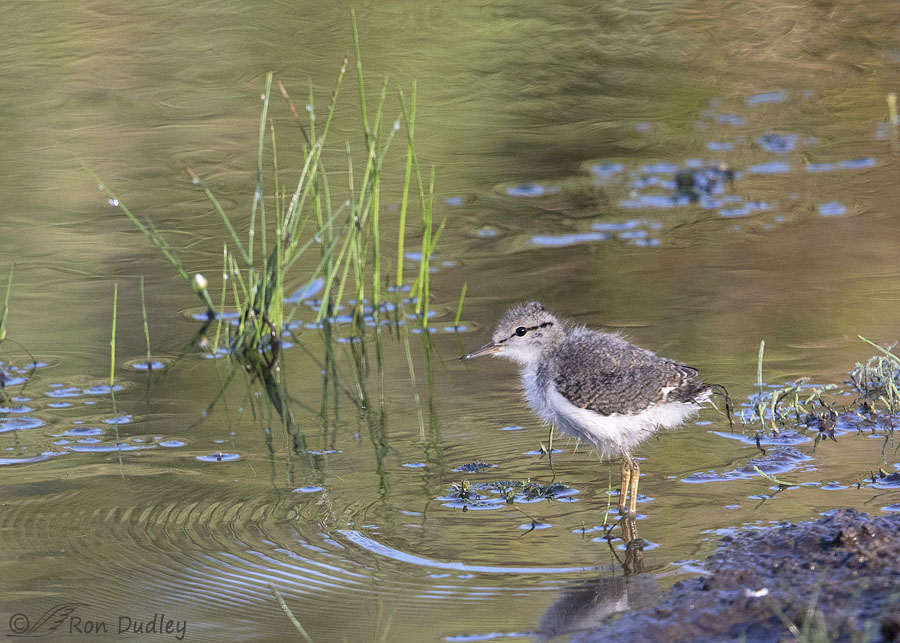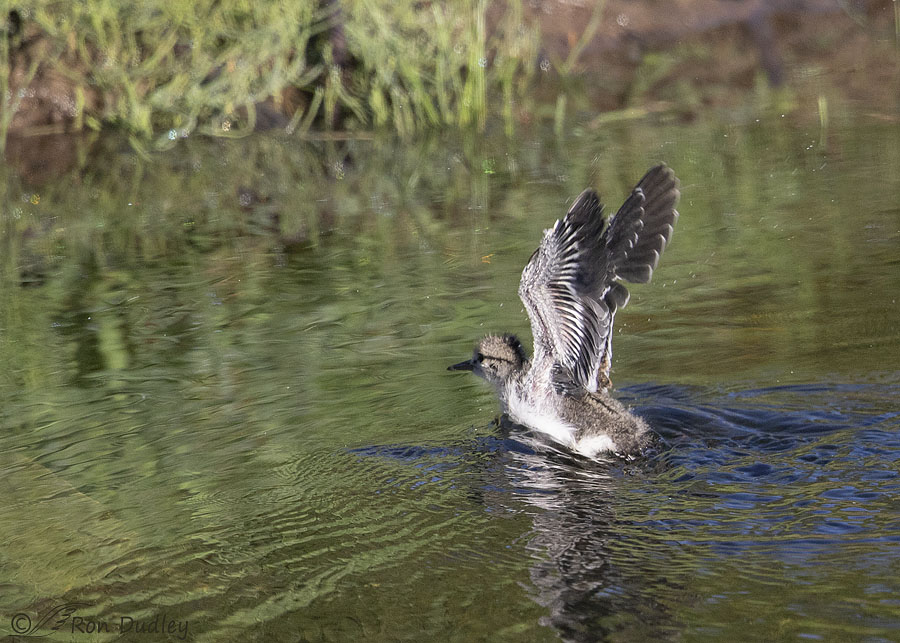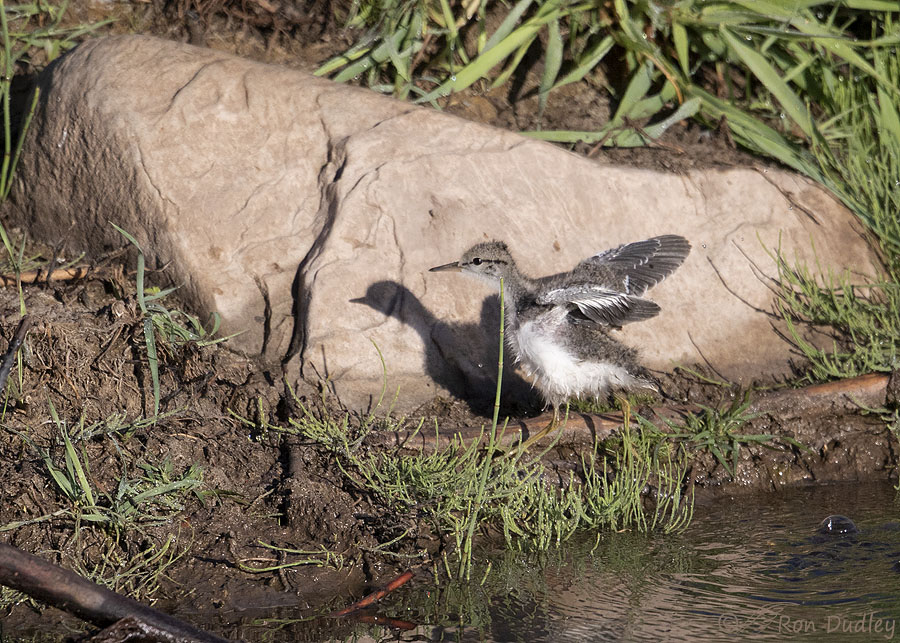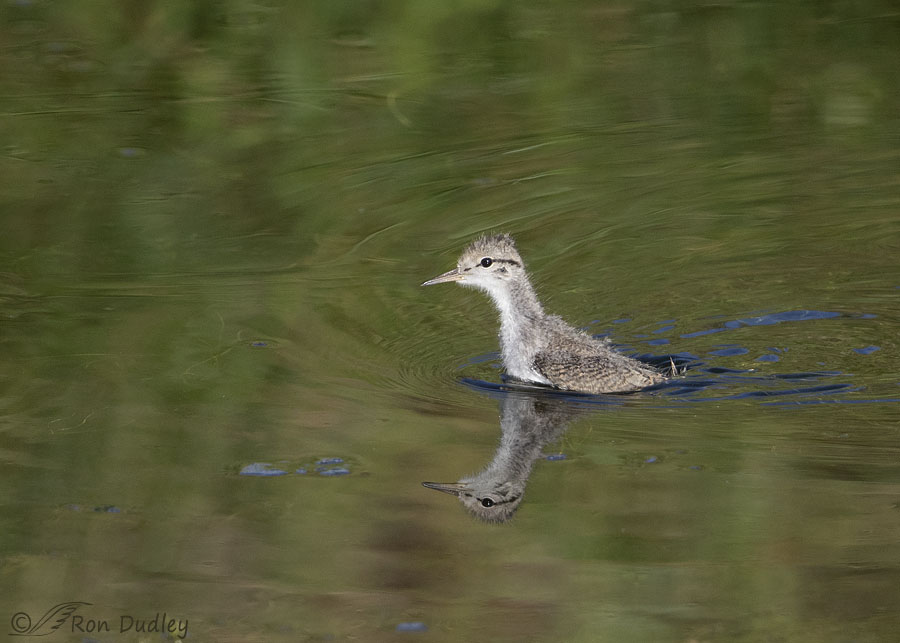A single day can make a big difference in the learning curve of a very young Spotted Sandpiper.
Every year I watch for the appearance of newly fledged Spotted Sandpiper chicks at a beaver pond in the mountains. A few days ago this year’s small batch made their debut.

As usual there were only two of them but they’re easy to spot as they forage in the mud and shallow water of the pond with one of the adults standing watch nearby. This photo of one of the tiny chicks was taken five days ago.

Both of the chicks like to forage on a sand bar in the middle of the pond but that means negotiating the deep (to them) water between the sand bar and the shore of the pond. Five days ago making that crossing was apparently an intimidating and scary adventure for them. If they could swim at this early stage in their lives they didn’t know it yet since they made the crossing in panic-mode, flapping their wings for the entire distance rather than swimming.
This one didn’t stop flapping until…

it had crossed the water and was safely up on the shore. On this day both chicks made the crossing by furiously flapping across the surface rather than swimming.

But the very next morning both chicks were making the crossing leisurely and confidently by swimming without using their wings at all. When their flight skills are fully developed they’ll fly across the open water rather than swim so I was delighted to actually photograph this one swimming.
My guess is that by now, four days later, they’re already flying with confidence so the window of opportunity for this bird photographer was a short one.
Ron


Catching up on blogs this morning. Been busy with feathered critters. The image of the bird with it’s wings up looks like he is trying to keep his wings dry.
They are so cute at this stage, but it doesn’t last long. I saw them this morning and it looks like adult plumage is coming in already.
Nice to know they’re still there, April.
Love all of these photos— and the wonderful narrative — but that first image is so lovely, with ripples on the reflecting water and the calm but seemingly determined young Sandpiper (with its drippy little tail feathers). Fledglings are just a total delight as they learn to make their way in the world! Thank you for showing us yet another example of the infinite variety of lessons to be learned.
I’m glad you noticed those ripples, Chris. While I was processing the image I spent nearly as much time looking at them as I did looking at the bird.
What complete and utter charmers. Who learn at a speed I envy.
Like Laura I wish that I had a biology teacher of your calibre.
Sadly biology was taught (at school and considered by my family) as a ‘lesser’ science. I often wonder whether this is a partial explanation for the damage our species has done and continues to do…
Ouch. Referring to biology as a lesser science hurts! It’s tragic that that attitude prevailed in your school, EC.
Tragic. And simply WRONG.
Sadly, I once had a graduate student from another department who asked to take my course (senior/grad level Ornithology course) but was then told she could not do so. He major professor (not in Biology) didn’t consider a course on bird biology to be serious or worthwhile science.
I am very sorry to read this Dan. It is sad confirmation that the prejudice against biology wasn’t limited to my school or country.
Dan, In my view what that professor did is grounds for losing his/her job. Or at least a demotion.
You post brought back a memory. Several years ago I was walking in the North Cascade mountains and came by a Spotted Sandpiper with nest and eggs. I assumed it was a female, but now realize it could have been a male. BoA refers to high levels of prolactin in the male. You sure have a knack for inspiring me to look a little deeper… Thanks.
Lyle, – The adult you saw on the nest was almost certainly a male as males do nearly all of the incubation in this species. At first, females may help with parental duties, but they soon court other mates, leaving the first male to finish parental duties. Females have the higher level of testosterone, do the courting and have a series of males they mate with, but seldom ever do incubation and often don’t provide care for young as they mate with more males.
Yeah, Spotted Sandpipers have really weird reversed sex roles. Which is why I didn’t mention the sex of the adult watching over these chicks.
What a cute little goober! These little ones, both birds and mammals, have such a steep learning curve, but luckily, most of them learn rapidly! Would that humans could learn as quickly…r even at all!
I’m going to echo what others have said. If you had been my high school biology teacher, you would most likely have changed the trajectory of my life. Instead, my biology teacher was a lecherous old guy who was far more interested in looking at girls’ legs and up their skirts than teaching biology. He was one of three huge reasons I quit high school.
Laura, it makes me more than sad to learn of teachers like that. It makes me very angry.
Ron, the good news is we’re never too old to learn. Remembering is another issue, but the learning part is just flat FUN! <3
Excellent series of photos. You can see the look of determination in the second photo as he keeps his ‘eyes on the prize.’ I really like that last photo with the near perfect reflection! They remind me of baby killdeer…a fuzzy golfball on stilts.
They remind me of baby killdeer…a fuzzy golfball on stilts.
Thank you, Kathy.
Miraculous-only 1 day to learn a survival skill like that ! It struck me as
unusually “dear” to have a little downy fluff ball of a body on top of those
long, long legs…..
Kris, I suspect they were capable of swimming all along. They just didn’t know it…
This is so precious, and so informative! I didn’t know about this behavior! Thank you for brightening my Sunday morning.
I didn’t know about it until recently either, Gail.
Maybe if Ron had been teaching back in 1952 in my 9th grade biology class I might have liked it. Had zero interest at that time, but now it would most likely be my favorite subject. Fun photos Ron watching those little guys and gals learn something new every day. No time to waste growing up in nature – it’s all about survival and the lessons have to be learned quickly.
Thanks for that vote of confidence, Everett.
To be honest I didn’t think my high school biology teacher was very good either. But I wasn’t a very good student back then so that may not be a fair assessment.
Ditto for me on that Ron
I’ve never thought of the sandpipers actually “swimming”…. Great series on the babes and their learning curve……..
Thank you, Judy. I suspect this short period while they’re very young might be the only time they swim.
Wonderful shots!!
I just have to say, regardless how it is taken, that I look forward every day to opening both your blog and your timeline to see your photographs and read your post when possible. I can understand why your students so enjoyed your teaching! Wish I had had you as a colleague!
Stay safe!
What a kind thing to say, especially coming from a fellow biology teacher. Thank you, Dick.
I’m very curious how birds like this, Moorehens & others with similar feet can swim with ease, after all their feet are not webbed. Great photos & thanks for sharing.
Good question, Elmer.
On the other hand mammal feet aren’t webbed and most of them can swim.
On another hand mammals swim with four legs rather than just two like birds.
On yet another hand mammals don’t have the added advantage of air-trapping feathers to provide additional buoyancy.
That’s a lot of hands but it’s a complicated equation…
Excellent – wasn’t thinking of mammals or feathers trapping air!